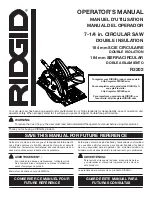
9 - English
ASSEMBLY
WARNING:
7-1/4 in. blade is the maximum blade capacity of
the saw. Also, never use a blade that is too thick
to allow outer blade washer to engage with the
flat on the spindle. Larger blades will come in
contact with the blade guides, while thicker blades
will prevent blade screw from securing blade on
spindle. Either of these situations could result in a
serious accident.
CAUTION:
To prevent damage to the spindle or spindle lock,
always allow motor to come to a complete stop
before engaging spindle lock.
ATTACHING BLADE
See Figures 2 - 3, page 17.
Unplug the saw.
Depress and hold spindle lock.
Remove blade screw by turning it counterclockwise with
the 6 mm blade wrench, while
keeping the spindle lock
button depressed.
Remove outer blade washer (“D” washer).
WARNING:
If inner flange bushing has been removed, replace
it before placing blade on spindle. Failure to do
so will prevent blade from tightening properly and
could result in serious personal injury.
Retract the lower guard into the upper guard, making
sure the lower guard spring works properly, allowing the
guard to move freely.
Check to see that the saw teeth and arrow on the saw
blade and the arrow on the lower guard are pointing in
the same direction.
NOTE:
The saw teeth point upward at the front of the
saw as shown.
Fit the saw blade inside the lower blade guard and onto
the spindle.
Replace “D” washer.
Depress spindle lock and replace blade screw.
Tighten blade screw securely by turning it clockwise with
the 6 mm blade wrench.
NOTE:
Never use a blade that is too thick to allow the
“D” washer to engage with the flats on the spindle.
REMOVING BLADE
See Figure 2 - 3, page 17.
Unplug the saw.
Depress and hold spindle lock.
Remove blade screw by turning it counterclockwise with
the provided 6 mm blade wrench, while keeping the
spindle lock depressed.
Remove outer blade washer (“D” washer).
Lift lower blade guard.
Remove blade.










































